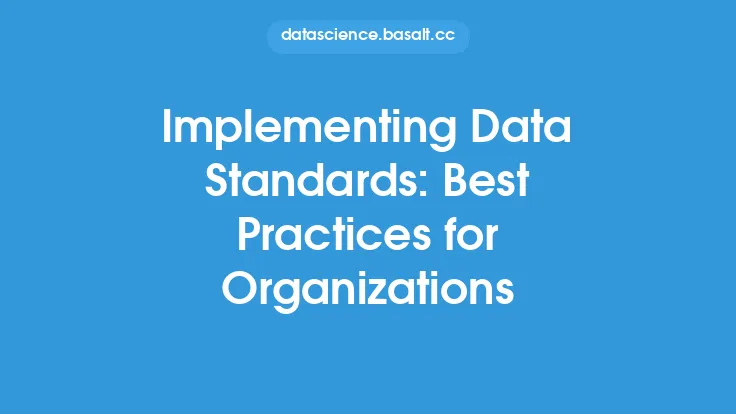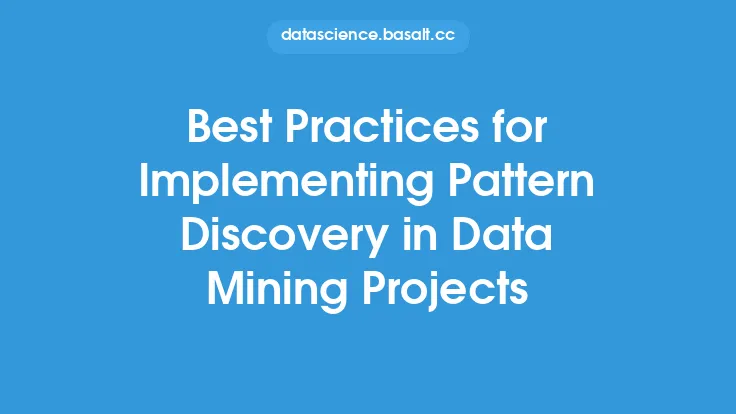Implementing data lineage in an organization is a complex task that requires careful planning, execution, and maintenance. Data lineage is the process of tracking the origin, movement, and transformation of data throughout its entire lifecycle. It provides a clear understanding of how data is created, processed, and used, which is essential for ensuring data quality, reliability, and transparency. In this article, we will discuss the best practices for implementing data lineage in your organization, including the technical and non-technical aspects of the process.
Introduction to Data Lineage Implementation
Implementing data lineage requires a thorough understanding of the organization's data landscape, including the various data sources, systems, and processes that handle data. It also requires a clear definition of the scope and goals of the data lineage initiative. The first step in implementing data lineage is to identify the key stakeholders and their roles in the process. This includes data owners, data stewards, and data consumers, as well as the IT teams responsible for managing the data infrastructure. Once the stakeholders are identified, the next step is to define the data lineage requirements, including the types of data to be tracked, the level of granularity, and the frequency of updates.
Data Lineage Architecture
A well-designed data lineage architecture is critical to the success of the initiative. The architecture should include the following components: data sources, data processing systems, data storage systems, and data visualization tools. The data sources component includes all the systems and applications that generate or collect data, such as databases, files, and external data feeds. The data processing systems component includes all the systems and applications that transform, aggregate, or manipulate data, such as ETL tools, data warehouses, and big data platforms. The data storage systems component includes all the systems and applications that store data, such as databases, data lakes, and file systems. The data visualization tools component includes all the systems and applications that provide a graphical representation of the data lineage, such as data lineage diagrams, data flow charts, and data catalogs.
Data Lineage Tools and Technologies
There are several data lineage tools and technologies available in the market, including commercial and open-source options. Some of the popular data lineage tools include Informatica, Talend, and Collibra. These tools provide a range of features, including data discovery, data mapping, data quality, and data governance. They also provide integration with various data sources and systems, including databases, data warehouses, and big data platforms. In addition to commercial tools, there are also several open-source data lineage tools available, including Apache Atlas, Apache NiFi, and Data Lineage Open Source. These tools provide a range of features, including data ingestion, data processing, and data visualization.
Data Lineage Metadata Management
Metadata management is a critical aspect of data lineage implementation. Metadata includes all the information about the data, such as data definitions, data formats, and data relationships. A well-designed metadata management system should include the following components: metadata repository, metadata ingestion, metadata processing, and metadata visualization. The metadata repository component includes a centralized repository that stores all the metadata, including data definitions, data formats, and data relationships. The metadata ingestion component includes the processes and tools that collect metadata from various data sources and systems. The metadata processing component includes the processes and tools that transform, aggregate, and manipulate metadata. The metadata visualization component includes the tools and technologies that provide a graphical representation of the metadata, such as data catalogs, data dictionaries, and metadata graphs.
Data Lineage Governance and Compliance
Data lineage governance and compliance are critical aspects of data lineage implementation. Governance includes all the policies, procedures, and standards that ensure the quality, reliability, and transparency of the data lineage. Compliance includes all the regulatory and industry requirements that must be met, such as GDPR, HIPAA, and SOX. A well-designed data lineage governance and compliance framework should include the following components: data lineage policies, data lineage procedures, data lineage standards, and data lineage monitoring. The data lineage policies component includes all the rules and regulations that govern the data lineage, including data ownership, data stewardship, and data quality. The data lineage procedures component includes all the processes and tasks that ensure the data lineage is accurate, complete, and up-to-date. The data lineage standards component includes all the technical and non-technical standards that ensure the data lineage is consistent and reliable. The data lineage monitoring component includes all the tools and technologies that monitor the data lineage for compliance and governance issues.
Data Lineage Best Practices
There are several best practices that can help ensure the success of the data lineage initiative. These include: define the scope and goals of the data lineage initiative, identify the key stakeholders and their roles, define the data lineage requirements, design a well-architected data lineage system, implement a robust metadata management system, establish a data lineage governance and compliance framework, and monitor and maintain the data lineage system. Additionally, it is essential to provide training and support to the stakeholders, including data owners, data stewards, and data consumers. It is also essential to establish a data lineage community of practice, including regular meetings, workshops, and conferences.
Data Lineage Challenges and Limitations
Implementing data lineage can be challenging, and there are several limitations and obstacles that must be overcome. These include: data complexity, data volume, data variety, data velocity, and data veracity. Data complexity refers to the complexity of the data sources, systems, and processes that handle data. Data volume refers to the large amounts of data that must be processed and analyzed. Data variety refers to the different types of data that must be handled, including structured, semi-structured, and unstructured data. Data velocity refers to the speed at which data is generated, processed, and analyzed. Data veracity refers to the accuracy, completeness, and reliability of the data. To overcome these challenges and limitations, it is essential to have a well-designed data lineage architecture, a robust metadata management system, and a strong data lineage governance and compliance framework.
Data Lineage Future Directions
The future of data lineage is exciting and rapidly evolving. There are several trends and technologies that are emerging, including artificial intelligence, machine learning, and cloud computing. Artificial intelligence and machine learning can be used to automate the data lineage process, including data discovery, data mapping, and data quality. Cloud computing can be used to provide a scalable and flexible infrastructure for data lineage, including data storage, data processing, and data visualization. Additionally, there are several emerging standards and technologies, including data catalogs, data dictionaries, and metadata graphs. These standards and technologies can help provide a common language and framework for data lineage, including data definitions, data formats, and data relationships.
Data Lineage Conclusion
Implementing data lineage in an organization is a complex task that requires careful planning, execution, and maintenance. It requires a thorough understanding of the organization's data landscape, including the various data sources, systems, and processes that handle data. It also requires a clear definition of the scope and goals of the data lineage initiative, as well as a well-designed data lineage architecture, a robust metadata management system, and a strong data lineage governance and compliance framework. By following the best practices and guidelines outlined in this article, organizations can ensure the success of their data lineage initiative and achieve the benefits of improved data quality, reliability, and transparency.





